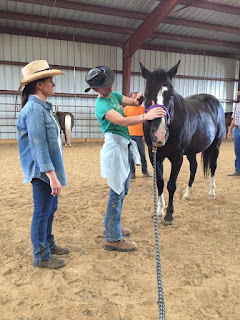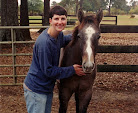This image really struck me because of
the beauty, ease, grace, and peace of it. I had gotten used to having fights
with my horse, and I had been assuming that he wanted, not necessarily to have
those fights, but at least to resist what I was asking. It was beyond refreshing
to consider that there was an entirely different way and that, if I gave him
the opportunity, my horse could be an entirely different (and happier) horse.
One hugely wonderful part of my 10-day
course was learning more about openings. In the dojo, I learned not only to
soften myself from the inside, but to allow a connection to happen that in turn
allowed my partner and myself to move together with our insides connected.
Opening myself like this became the first step, always, for finding and
creating openings with the horses.
The Masterson Method work, geared
toward helping the horse release tension and allow his joints to be moved
freely in a state of relaxation, then taught me how to look for openings in the
horse. I learned to feel for where the horse *could* relax and to start there,
instead of focusing on the area that I felt he needed to relax or on the
technique that I was trying to do. Any place the horse was able to relax was
the opening to creating more relaxation.
And this idea carried through to the
riding too. If we focus on what the horse can't/won't/doesn't want to do, that
generally means that we're focused on where the brace is, which means that
movement is difficult and, if it does happen, filled with tension.
But if we focus on where the horse is
already moving with ease, we can go through that opening together with him and
build from there. That may mean turning left instead of right, or walking
instead of trotting, or backing up instead of going forward. But what it means
above all is being truly dedicated to listening to what the horse is telling us
feels okay and blending with and building on that instead of pursuing our own
agenda of what we think he should do.
This doesn't mean that we do whatever
the horse wants. But it does mean that we let him tell us how we can get where
we're trying to go instead of just pushing him into it.
The moment this really became clear for
me was when I was working with Comet on backing. Comet tended to put his head
down and brace defensively against going backward. Mark showed me how to lift
his head to where he didn't have a brace and ask for a soft backwards from
there, rather than continuing to focus on backing from the point where he was
braced. And then Comet and I moved easily and beautifully backward.
Maybe if we want our horses to move
like water, we need to be willing to have a little of the ability to flow to
where there's an opening ourselves.
* * *
On the last day I realized that looking
for openings is my own opening to a better perspective. I tend to focus on what
needs fixing, what still needs work, what we can't yet do. In short, I see only
the negatives. And it's all well and good to say something like, "Focus on
helping the horse relax," but it takes my critical brain only a nanosecond
to turn that into, "My horse isn't relaxed!" And then we're right
back to focusing on the negative.
If I am looking for openings, however,
I don't have room to see negatives. If it isn't an opening, then I am simply
moving on to what is one. There's no point in making judgments because I'm not
interested in judging: I'm interested in finding.







No comments:
Post a Comment